-
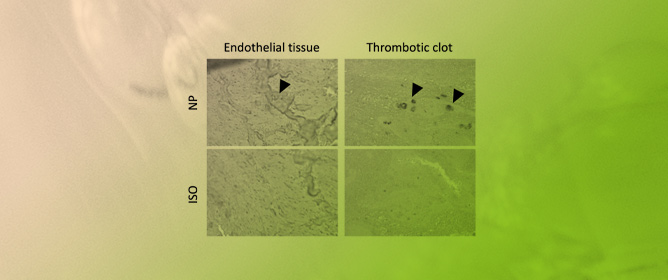 In Situ Endothelial SARS-CoV-2 Presence and PROS1 Plasma Levels Alteration in SARS-CoV-2-Associated Coagulopathies
In Situ Endothelial SARS-CoV-2 Presence and PROS1 Plasma Levels Alteration in SARS-CoV-2-Associated Coagulopathies -
![Induction of Arterial Inflammation by Immune Checkpoint Inhibitor Therapy in Lung Cancer Patients as Measured by 2-[<sup>18</sup>F]FDG Positron Emission Tomography/Computed Tomography Depends on Pre-Existing Vascular Inflammation](https://pub.mdpi-res.com/title_story/title_story_17105057485939.jpg?1713959567) Induction of Arterial Inflammation by Immune Checkpoint Inhibitor Therapy in Lung Cancer Patients as Measured by 2-[18F]FDG Positron Emission Tomography/Computed Tomography Depends on Pre-Existing Vascular Inflammation
Induction of Arterial Inflammation by Immune Checkpoint Inhibitor Therapy in Lung Cancer Patients as Measured by 2-[18F]FDG Positron Emission Tomography/Computed Tomography Depends on Pre-Existing Vascular Inflammation -
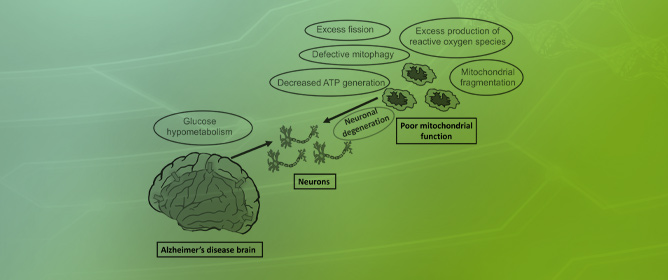 Mitochondria in Alzheimer’s Disease Pathogenesis
Mitochondria in Alzheimer’s Disease Pathogenesis -
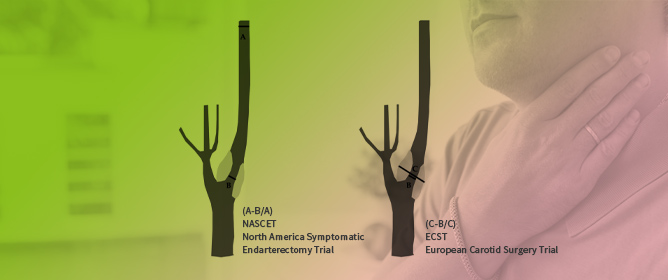 Quantifying Carotid Stenosis: History, Current Applications, Limitations, and Potential: How Imaging Is Changing the Scenario
Quantifying Carotid Stenosis: History, Current Applications, Limitations, and Potential: How Imaging Is Changing the Scenario
Journal Description
Life
Life
is an international, peer-reviewed, open access journal of scientific studies related to fundamental themes in life sciences, from basic to applied research, published monthly online by MDPI. The Astrobiology Society of Britain (ASB) and Spanish Association for Cancer Research (ASEICA) are affiliated with Life and their members receive a discount on the article processing charges.
- Open Access— free for readers, with article processing charges (APC) paid by authors or their institutions.
- High Visibility: indexed within Scopus, SCIE (Web of Science), PubMed, PMC, CAPlus / SciFinder, AGRIS, and other databases.
- Journal Rank: JCR - Q2 (Biology) / CiteScore - Q2 (Paleontology)
- Rapid Publication: manuscripts are peer-reviewed and a first decision is provided to authors approximately 17.5 days after submission; acceptance to publication is undertaken in 2.5 days (median values for papers published in this journal in the second half of 2023).
- Recognition of Reviewers: reviewers who provide timely, thorough peer-review reports receive vouchers entitling them to a discount on the APC of their next publication in any MDPI journal, in appreciation of the work done.
- Testimonials: See what our editors and authors say about Life.
- Companion journals for Life include: Gastroenterology Insights, Physiologia, Hydrobiology, and Anatomia.
Impact Factor:
3.2 (2022);
5-Year Impact Factor:
3.2 (2022)
Latest Articles
Chrono-Endocrinology in Clinical Practice: A Journey from Pathophysiological to Therapeutic Aspects
Life 2024, 14(5), 546; https://doi.org/10.3390/life14050546 (registering DOI) - 24 Apr 2024
Abstract
This review was aimed at collecting the knowledge on the pathophysiological and clinical aspects of endocrine rhythms and their implications in clinical practice, derived from the published literature and from some personal experiences on this topic. We chose to review, according to the
[...] Read more.
This review was aimed at collecting the knowledge on the pathophysiological and clinical aspects of endocrine rhythms and their implications in clinical practice, derived from the published literature and from some personal experiences on this topic. We chose to review, according to the PRISMA guidelines, the results of original and observational studies, reviews, meta-analyses and case reports published up to March 2024. Thus, after summarizing the general aspects of biological rhythms, we will describe the characteristics of several endocrine rhythms and the consequences of their disruption, paying particular attention to the implications in clinical practice. Rhythmic endocrine secretions, like other physiological rhythms, are genetically determined and regulated by a central hypothalamic CLOCK located in the suprachiasmatic nucleus, which links the timing of the rhythms to independent clocks, in a hierarchical organization for the regulation of physiology and behavior. However, some environmental factors, such as daily cycles of light/darkness, sleep/wake, and timing of food intake, may influence the rhythm characteristics. Endocrine rhythms are involved in important physiological processes and their disruption may cause several disorders and also cancer. Thus, it is very important to prevent disruptions of endocrine rhythms and to restore a previously altered rhythm by an early corrective chronotherapy.
Full article
(This article belongs to the Section Physiology and Pathology)
Open AccessReview
Vascular Alterations following COVID-19 Infection: A Comprehensive Literature Review
by
Paschalis Karakasis, Athina Nasoufidou, Marios Sagris, Nikolaos Fragakis and Konstantinos Tsioufis
Life 2024, 14(5), 545; https://doi.org/10.3390/life14050545 - 24 Apr 2024
Abstract
SARS-CoV-2, the causative agent of the ongoing COVID-19 pandemic, has revealed a broader impact beyond the respiratory system, predominantly affecting the vascular system with various adverse manifestations. The infection induces endothelial dysfunction and immune system dysregulation, creating an inflammatory and hypercoagulable state. It
[...] Read more.
SARS-CoV-2, the causative agent of the ongoing COVID-19 pandemic, has revealed a broader impact beyond the respiratory system, predominantly affecting the vascular system with various adverse manifestations. The infection induces endothelial dysfunction and immune system dysregulation, creating an inflammatory and hypercoagulable state. It affects both microvasculature and macrovasculature, leading to thromboembolic events, cardiovascular manifestations, impaired arterial stiffness, cerebrovascular complications, and nephropathy, as well as retinopathy—frequently observed in cases of severe illness. Evidence suggests that SARS-CoV-2 infection may result in persistent effects on the vascular system, identified as long-term COVID-19. This is characterized by prolonged inflammation, endotheliopathy, and an increased risk of vascular complications. Various imaging modalities, histopathological studies, and diagnostic tools such as video capillaroscopy and magnetic resonance imaging have been employed to visualize vascular alterations. This review aims to comprehensively summarize the evidence concerning short and long-term vascular alterations following COVID-19 infection, investigating their impact on patients’ prognosis, and providing an overview of preventive strategies to mitigate associated vascular complications.
Full article
(This article belongs to the Special Issue Interdisciplinarity in Cardiovascular Diseases: From Pathophysiology to Diagnosis and Treatment—2nd Edition)
Open AccessArticle
Investigating Immunotoxicity in Black Carp (Mylopharyngodon piceus) Fingerlings Exposed to Niclosamide
by
Hao Wu, Xiping Yuan, Xing Tian, Jinwei Gao, Min Xie, Zhonggui Xie, Rui Song and Dongsheng Ou
Life 2024, 14(5), 544; https://doi.org/10.3390/life14050544 (registering DOI) - 24 Apr 2024
Abstract
Niclosamide (NIC) is a potent salicylanilide molluscicide/helminthicide commonly utilized for parasite and mollusc control in aquatic environments. Due to its persistent presence in water bodies, there is growing concern regarding its impact on aquatic organisms, yet this remains inadequately elucidated. Consequently, this study
[...] Read more.
Niclosamide (NIC) is a potent salicylanilide molluscicide/helminthicide commonly utilized for parasite and mollusc control in aquatic environments. Due to its persistent presence in water bodies, there is growing concern regarding its impact on aquatic organisms, yet this remains inadequately elucidated. Consequently, this study aims to assess the hepatotoxic effects and detoxification capacity of black carp (Mylopharyngodon piceus) in a semi-static system, employing various parameters for analysis. NIC was applied to juvenile black carp at three different concentrations (0, 10 and 50 μg/L) for 28 days in an environmentally realistic manner. Exposure to 50 μg/L NIC resulted in an increase in hepatic lysozyme (LYZ), alkaline phosphatase (ALP), and complement 4 (C4) levels while simultaneously causing a decrease in peroxidase (POD) activity. Additionally, NIC exposure exhibited a dose-dependent effect on elevating serum levels of LYZ, ALP, complement 3 (C3), C4, and immunoglobulin T (IgT). Notably, the mRNA levels of immune-related genes tnfα, il8, and il6, as well as nramp and leap2, were upregulated in fish exposed to NIC. RNA-Seq analysis identified 219 differentially expressed genes (DEGs) in M. piceus after NIC exposure, with 94 upregulated and 125 downregulated genes. KEGG and GO analyses showed enrichment in drug metabolism pathways and activities related to oxidoreductase, lip oprotein particles, and cholesterol transport at 50 μg/L NIC. Additionally, numerous genes associated with lipid metabolism, oxidative stress, and innate immunity were upregulated in NIC-exposed M. piceus. Taken together, these findings indicate that NIC has the potential to cause hepatotoxicity and immunotoxicity in M. piceus. This research offers important insights for further understanding the impact of molluscicide/helminthicide aquatic toxicity in ecosystems.
Full article
(This article belongs to the Special Issue Feature Papers in Animal Science: 2nd Edition)
►▼
Show Figures

Figure 1
Open AccessArticle
Focal Traumatic Brain Injury Impairs the Integrity of the Basement Membrane of Hindlimb Muscle Fibers Revealed by Extracellular Matrix Immunoreactivity
by
Mette Albæk Kristensen, Karen Kalhøj Rich, Tobias Christian Mogensen, Andreas Malmquist Damsgaard Jensen, Åsa Fex Svenningsen and Mengliang Zhang
Life 2024, 14(5), 543; https://doi.org/10.3390/life14050543 - 24 Apr 2024
Abstract
Traumatic brain injury (TBI) stands as a prominent global cause of disability, with motor deficits being a common consequence. Despite its widespread impact, the precise pathological mechanisms underlying motor deficits after TBI remain elusive. In this study, hindlimb postural asymmetry (HL-PA) development
[...] Read more.
Traumatic brain injury (TBI) stands as a prominent global cause of disability, with motor deficits being a common consequence. Despite its widespread impact, the precise pathological mechanisms underlying motor deficits after TBI remain elusive. In this study, hindlimb postural asymmetry (HL-PA) development in rats subjected to focal TBI was investigated to explore the potential roles of collagen IV and laminin within the extracellular matrix (ECM) of selected hindlimb muscles in the emergence of motor deficits following TBI. A focal TBI was induced by ablating the left sensorimotor cortex in rats and motor deficits were assessed by measuring HL-PA. The expression of laminin and collagen IV in eight selected muscles on each side of the hindlimbs from both TBI- and sham-operated rats were studied using immunohistochemistry and semi-quantitatively analyzed. The results indicated that the TBI rats exhibited HL-PA, characterized by flexion of the contralateral (right) hindlimb. In the sham-operated rats, the immunoreactive components of laminin and collagen IV were evenly and smoothly distributed along the border of the muscle fibers in all the investigated muscles. In contrast, in the TBI rats, the pattern was broken into aggregated, granule-like, immunoreactive components. Such a labeling pattern was detected in all the investigated muscles both from the contra- and ipsilateral sides of the TBI rats. However, in TBI rats, most of the muscles from the contralateral hindlimb showed a significantly increased expression of these two proteins in comparison with those from the ipsilateral hindlimb. In comparison to sham-operated rats, there was a significant increase in laminin and collagen IV expression in various contralateral hindlimb muscles in the TBI rats. These findings suggest potential implications of laminin and collagen IV in the development of motor deficits following a focal TBI.
Full article
(This article belongs to the Special Issue Motor Deficits Caused by Neurological Disorders: From Mechanism to Treatment)
Open AccessReview
Management of Refractory Chronic Obstructive Pulmonary Disease: A Review
by
Mandeep Singh Rahi, Mayuri Mudgal, Bharat Kumar Asokar, Prashanth Reddy Yella and Kulothungan Gunasekaran
Life 2024, 14(5), 542; https://doi.org/10.3390/life14050542 - 24 Apr 2024
Abstract
Chronic obstructive pulmonary disease (COPD) is a common condition with an estimated prevalence of 12% in adults over the age of 30 years worldwide. COPD is a leading cause of morbidity and mortality globally, with a substantial economic and social burden. There are
[...] Read more.
Chronic obstructive pulmonary disease (COPD) is a common condition with an estimated prevalence of 12% in adults over the age of 30 years worldwide. COPD is a leading cause of morbidity and mortality globally, with a substantial economic and social burden. There are an estimated 3 million deaths annually due to COPD. However, most of the patients with COPD respond to routine interventions like bronchodilator therapy, assessing supplemental oxygen needs, smoking cessation, vaccinations, and pulmonary rehabilitation. There is a significant number of patients who unfortunately progress to have persistent symptoms despite these interventions. Refractory COPD is not yet formally defined. Patients with severe persistent symptoms or exacerbations despite appropriate care can be considered to have refractory COPD. Managing refractory COPD needs a multidimensional approach. In this review article, we will discuss essential interventions like ensuring adequate inhaler techniques, exploring the need for non-invasive ventilatory support, use of chronic antibiotics and phosphodiesterase inhibitors to advanced therapies like bronchoscopic lung volume reduction surgery, and the upcoming role of anti-IL5 agents in managing patients with refractory COPD. We will also discuss non-pharmacologic interventions like psycho-social support and nutritional support. We will conclude by discussing the palliative care aspect of managing patients with refractory COPD. Through this review article, we aim to better the approach to managing patients with refractory COPD and discuss new upcoming therapies.
Full article
(This article belongs to the Section Medical Research)
►▼
Show Figures

Figure 1
Open AccessArticle
Characteristics of the Follicular Fluid Extracellular Vesicle Molecular Profile in Women in Different Age Groups in ART Programs
by
Anastasia Sysoeva, Zumriyat Akhmedova, Oksana Nepsha, Natalya Makarova, Denis Silachev, Yulia Shevtsova, Kirill Goryunov, Victoria Karyagina, Anna Bugrova, Natalya Starodubtseva, Anastasia Novoselova, Vitaliy Chagovets and Elena Kalinina
Life 2024, 14(5), 541; https://doi.org/10.3390/life14050541 - 24 Apr 2024
Abstract
The aim of this study was to investigate the molecular composition of follicular fluid (FF) extracellular vesicles (EVs) in women of different reproductive ages and its possible relationship to sperm fertilizing ability. FF EVs were obtained by differential centrifugation. The concentration and size
[...] Read more.
The aim of this study was to investigate the molecular composition of follicular fluid (FF) extracellular vesicles (EVs) in women of different reproductive ages and its possible relationship to sperm fertilizing ability. FF EVs were obtained by differential centrifugation. The concentration and size distribution of FF EVs were analyzed by nanoparticle tracking analysis. The lipidome and proteome were analyzed by liquid chromatography–mass spectrometry. The isolated FF EVs had a variety of shapes and sizes; their concentration and size distribution did not differ significantly between the age groups. In women younger than 35 years, the concentration of vesicular progesterone was 6.6 times higher than in women older than 35 years, and the total levels of the main lipid classes were increased in younger women. A proteomic analysis revealed that not only FF EV-specific proteins, but also proteins involved in sperm activation were present. New data were obtained on the composition of FF EVs, confirming their importance as molecular indicators of age-related changes in the female reproductive system. In addition, these results shed light on the possible interaction between the FF EVs of women in different age groups and male germ cells. Therefore, studying the transcriptomic and metabolomic profile of FF EVs may be a crucial approach to evaluate the efficacy of ART.
Full article
(This article belongs to the Special Issue Human Infertility and Reproductive Endocrinology)
►▼
Show Figures
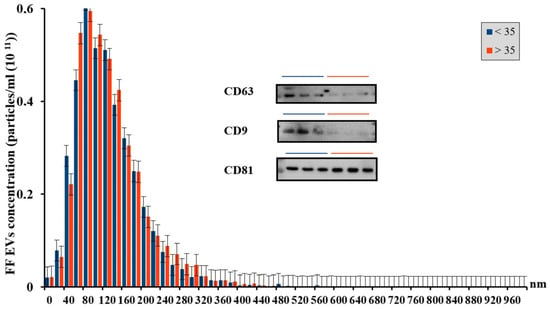
Figure 1
Open AccessReview
Immunological and Clinical Responses to Vaccinations among Adults Living with HIV
by
Carlo Bieńkowski, Zuzanna Żak, Filip Fijołek, Martyna Cholewik, Maciej Stępień, Agata Skrzat-Klapaczyńska and Justyna D. Kowalska
Life 2024, 14(5), 540; https://doi.org/10.3390/life14050540 - 24 Apr 2024
Abstract
People living with human immunodeficiency virus (HIV) are at higher risk of morbidity and mortality due to vaccine-preventable diseases. At the same time, they are less likely to respond to vaccinations, and might have a higher rate of vaccine adverse event and faster
[...] Read more.
People living with human immunodeficiency virus (HIV) are at higher risk of morbidity and mortality due to vaccine-preventable diseases. At the same time, they are less likely to respond to vaccinations, and might have a higher rate of vaccine adverse event and faster waning of protective effect. International and national guidelines emphasize the importance of vaccinating people living with HIV against respiratory system disease pathogens including seasonal influenza, Streptococcus pneumoniae, and COVID-19, as well as against sexually transmitted infections, i.e., Hepatitis A and B (HAV, HBV) and human papillomavirus (HPV). This narrative review aims to provide a comprehensive examination of the current knowledge regarding the immune and clinical responses elicited by vaccinations in the older adult population living with HIV.
Full article
(This article belongs to the Special Issue Exploration of the Unmet Needs of Aging People Living with HIV)
Open AccessArticle
No Object–Location Memory Improvement through Focal Transcranial Direct Current Stimulation over the Right Temporoparietal Cortex
by
Anna Elisabeth Fromm, Ulrike Grittner, Svenja Brodt, Agnes Flöel and Daria Antonenko
Life 2024, 14(5), 539; https://doi.org/10.3390/life14050539 - 23 Apr 2024
Abstract
Remembering objects and their associated location (object–location memory; OLM), is a fundamental cognitive function, mediated by cortical and subcortical brain regions. Previously, the combination of OLM training and transcranial direct current stimulation (tDCS) suggested beneficial effects, but the evidence remains heterogeneous. Here, we
[...] Read more.
Remembering objects and their associated location (object–location memory; OLM), is a fundamental cognitive function, mediated by cortical and subcortical brain regions. Previously, the combination of OLM training and transcranial direct current stimulation (tDCS) suggested beneficial effects, but the evidence remains heterogeneous. Here, we applied focal tDCS over the right temporoparietal cortex in 52 participants during a two-day OLM training, with anodal tDCS (2 mA, 20 min) or sham (40 s) on the first day. The focal stimulation did not enhance OLM performance on either training day (stimulation effect: −0.09, 95%CI: [−0.19; 0.02], p = 0.08). Higher electric field magnitudes in the target region were not associated with individual performance benefits. Participants with content-related learning strategies showed slightly superior performance compared to participants with position-related strategies. Additionally, training gains were associated with individual verbal learning skills. Consequently, the lack of behavioral benefits through focal tDCS might be due to the involvement of different cognitive processes and brain regions, reflected by participant’s learning strategies. Future studies should evaluate whether other brain regions or memory-relevant networks may be involved in the modulation of object–location associations, investigating other target regions, and further exploring individualized stimulation parameters.
Full article
(This article belongs to the Special Issue Technical Innovations in Transcranial Electrical Stimulation)
Open AccessCommunication
Year-Long Stability of Nucleic Acid Bases in Concentrated Sulfuric Acid: Implications for the Persistence of Organic Chemistry in Venus’ Clouds
by
Sara Seager, Janusz J. Petkowski, Maxwell D. Seager, John H. Grimes, Jr., Zachary Zinsli, Heidi R. Vollmer-Snarr, Mohamed K. Abd El-Rahman, David S. Wishart, Brian L. Lee, Vasuk Gautam, Lauren Herrington, William Bains and Charles Darrow
Life 2024, 14(5), 538; https://doi.org/10.3390/life14050538 - 23 Apr 2024
Abstract
We show that the nucleic acid bases adenine, cytosine, guanine, thymine, and uracil, as well as 2,6-diaminopurine, and the “core” nucleic acid bases purine and pyrimidine, are stable for more than one year in concentrated sulfuric acid at room temperature and at acid
[...] Read more.
We show that the nucleic acid bases adenine, cytosine, guanine, thymine, and uracil, as well as 2,6-diaminopurine, and the “core” nucleic acid bases purine and pyrimidine, are stable for more than one year in concentrated sulfuric acid at room temperature and at acid concentrations relevant for Venus clouds (81% w/w to 98% w/w acid, the rest water). This work builds on our initial stability studies and is the first ever to test the reactivity and structural integrity of organic molecules subjected to extended incubation in concentrated sulfuric acid. The one-year-long stability of nucleic acid bases supports the notion that the Venus cloud environment—composed of concentrated sulfuric acid—may be able to support complex organic chemicals for extended periods of time.
Full article
(This article belongs to the Section Astrobiology)
►▼
Show Figures
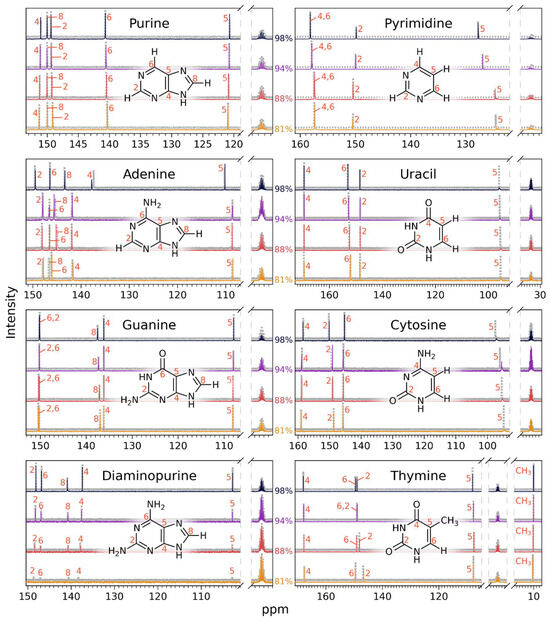
Figure 1
Open AccessReview
DNA Methylation Machinery in Gastropod Mollusks
by
Laura Haidar, Marius Georgescu, George Andrei Drăghici, Ioan Bănățean-Dunea, Dragoș Vasile Nica and Alina-Florina Șerb
Life 2024, 14(4), 537; https://doi.org/10.3390/life14040537 - 22 Apr 2024
Abstract
The role of DNA methylation in mollusks is just beginning to be understood. This review synthesizes current knowledge on this potent molecular hallmark of epigenetic control in gastropods—the largest class of mollusks and ubiquitous inhabitants of diverse habitats. Their DNA methylation machinery shows
[...] Read more.
The role of DNA methylation in mollusks is just beginning to be understood. This review synthesizes current knowledge on this potent molecular hallmark of epigenetic control in gastropods—the largest class of mollusks and ubiquitous inhabitants of diverse habitats. Their DNA methylation machinery shows a high degree of conservation in CG maintenance methylation mechanisms, driven mainly by DNMT1 homologues, and the presence of MBD2 and MBD2/3 proteins as DNA methylation readers. The mosaic-like DNA methylation landscape occurs mainly in a CG context and is primarily confined to gene bodies and housekeeping genes. DNA methylation emerges as a critical regulator of reproduction, development, and adaptation, with tissue-specific patterns being observed in gonadal structures. Its dynamics also serve as an important regulatory mechanism underlying learning and memory processes. DNA methylation can be affected by various environmental stimuli, including as pathogens and abiotic stresses, potentially impacting phenotypic variation and population diversity. Overall, the features of DNA methylation in gastropods are complex, being an essential part of their epigenome. However, comprehensive studies integrating developmental stages, tissues, and environmental conditions, functional annotation of methylated regions, and integrated genomic-epigenomic analyses are lacking. Addressing these knowledge gaps will advance our understanding of gastropod biology, ecology, and evolution.
Full article
(This article belongs to the Special Issue Feature Papers in Animal Science: 2nd Edition)
Open AccessArticle
The Anti-Cholinesterase Potential of Fifteen Different Species of Narcissus L. (Amaryllidaceae) Collected in Spain
by
Luciana R. Tallini, Giulia Manfredini, María Lenny Rodríguez-Escobar, Segundo Ríos, Vanessa Martínez-Francés, Gabriela E. Feresin, Warley de Souza Borges, Jaume Bastida, Francesc Viladomat and Laura Torras-Claveria
Life 2024, 14(4), 536; https://doi.org/10.3390/life14040536 - 22 Apr 2024
Abstract
Narcissus L. is a renowned plant genus with a notable center of diversity and is primarily located in the Mediterranean region. These plants are widely recognized for their ornamental value, owing to the beauty of their flowers; nonetheless, they also hold pharmacological importance.
[...] Read more.
Narcissus L. is a renowned plant genus with a notable center of diversity and is primarily located in the Mediterranean region. These plants are widely recognized for their ornamental value, owing to the beauty of their flowers; nonetheless, they also hold pharmacological importance. In Europe, pharmaceutical companies usually use the bulbs of Narcissus pseudonarcissus cv. Carlton to extract galanthamine, which is one of the few medications approved by the FDA for the palliative treatment of mild-to-moderate symptoms of Alzheimer’s disease. The purpose of this study was to evaluate the potential of these plants in Alzheimer’s disease. The alkaloid extract from the leaves of different species of Narcissus was obtained by an acid-base extraction work-up -procedure. The biological potential of the samples was carried out by evaluating their ability to inhibit the enzymes acetyl- and butyrylcholinesterase (AChE and BuChE, respectively). The species N. jacetanus exhibited the best inhibition values against AChE, with IC50 values of 0.75 ± 0.03 µg·mL−1, while N. jonquilla was the most active against BuChE, with IC50 values of 11.72 ± 1.15 µg·mL−1.
Full article
(This article belongs to the Special Issue Alkaloids: Extraction, Analysis and Function Research)
►▼
Show Figures
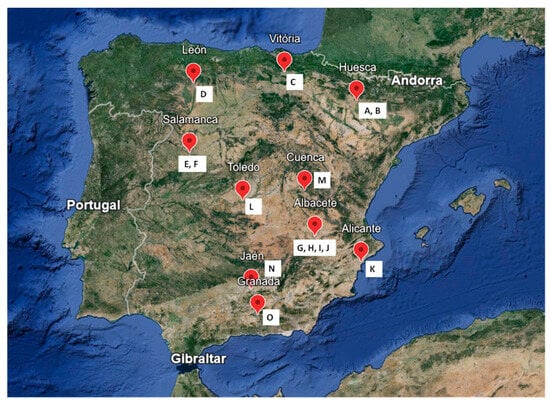
Figure 1
Open AccessArticle
Aflatoxins in Wheat Grains: Detection and Detoxification through Chemical, Physical, and Biological Means
by
Ahmed Mahmoud Ismail, Muhammad Hassan Raza, Naseem Zahra, Rafiq Ahmad, Yasar Sajjad and Sabaz Ali Khan
Life 2024, 14(4), 535; https://doi.org/10.3390/life14040535 - 22 Apr 2024
Abstract
Wheat (Triticum aestivum L.) is an essential food crop in terms of consumption as well as production. Aflatoxin exposure has a widespread public health impact in economically developing nations, so there is a need to establish preventive techniques for these high-risk populations. Pre-harvest
[...] Read more.
Wheat (Triticum aestivum L.) is an essential food crop in terms of consumption as well as production. Aflatoxin exposure has a widespread public health impact in economically developing nations, so there is a need to establish preventive techniques for these high-risk populations. Pre-harvest and post-harvest practices are the two strategies used to control aflatoxin contamination, which include the use of genetically modified crops that show resistance against Aspergillus infection, the use of pesticides, changing the planting and harvesting time of crops, and physical, chemical, and biological methods. In this research, aflatoxin detection and quantification were performed in different wheat varieties to determine quantitative differences in comparison to the European Commission’s limit of 4 ppb aflatoxins in wheat. TLC for qualitative and the ELISA kit method for quantitative analysis of aflatoxins were used. Out of 56 samples, 35 were found contaminated with aflatoxins, while the remaining 21 samples did not show any presence of aflatoxins. Out of the 35 contaminated samples, 20 samples showed aflatoxin contamination within the permissible limit, while the remaining 15 samples showed aflatoxin concentration beyond the permissible level, ranging from 0.49 to 20.56 ppb. After quantification, the nine highly contaminated wheat samples were detoxified using physical, chemical, and biological methods. The efficiency of these methods was assessed, and they showed a significant reduction in aflatoxins of 53–72%, 79–88%, and 80–88%, respectively. In conclusion, the difference in aflatoxin concentration in different wheat varieties could be due to genetic variations. Furthermore, biological treatment could be the method of choice for detoxification of aflatoxins in wheat as it greatly reduced the aflatoxin concentration with no harmful effect on the quality of the grains.
Full article
(This article belongs to the Special Issue Food Microbiological Contamination)
►▼
Show Figures
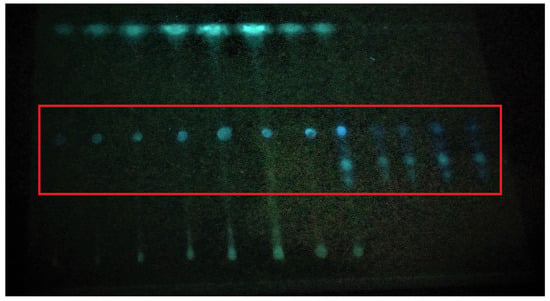
Figure 1
Open AccessArticle
Complete Mitochondrial Genome and Its Phylogenetic Position in Red Algae Fushitsunagia catenata from South Korea
by
Maheshkumar Prakash Patil, Nur Indradewi Oktavitri, Young-Ryun Kim, Seokjin Yoon, In-Cheol Lee, Jong-Oh Kim and Kyunghoi Kim
Life 2024, 14(4), 534; https://doi.org/10.3390/life14040534 - 22 Apr 2024
Abstract
The mitogenome is an important tool in taxonomic and evolutionary studies. Only a few complete mitogenomes have been reported for red algae. Herein, we reported the complete mitochondrial genome sequence of Fushitsunagia catenata (Harvey) Filloramo, G.V. and Saunders, G.W. 2016, a monospecific genus.
[...] Read more.
The mitogenome is an important tool in taxonomic and evolutionary studies. Only a few complete mitogenomes have been reported for red algae. Herein, we reported the complete mitochondrial genome sequence of Fushitsunagia catenata (Harvey) Filloramo, G.V. and Saunders, G.W. 2016, a monospecific genus. The genome was 25,889 bp in circumference and had a strongly biased AT of 70.4%. It consisted of 2 rRNAs, 23 tRNAs, and 24 protein-coding genes (PCGs). nad5 (1986 bp) was the largest and atp9 (231 bp) was the smallest PCG. All PCGs used ATG as an initiation codon and TAA as a termination codon, except TAG, which was the termination codon used in the sdh3, rps3, and rps11 genes. The general structure and gene content of the present findings were almost identical to those of other red algae genomes, particularly those of the Rhodymeniales order. The maximum likelihood analysis showed that F. catenata was closely related to Rhodymenia pseudopalmata. The mitochondrial genome data presented in this study will enhance our understanding of evolution in Rhodophyta species.
Full article
(This article belongs to the Section Genetics and Genomics)
►▼
Show Figures
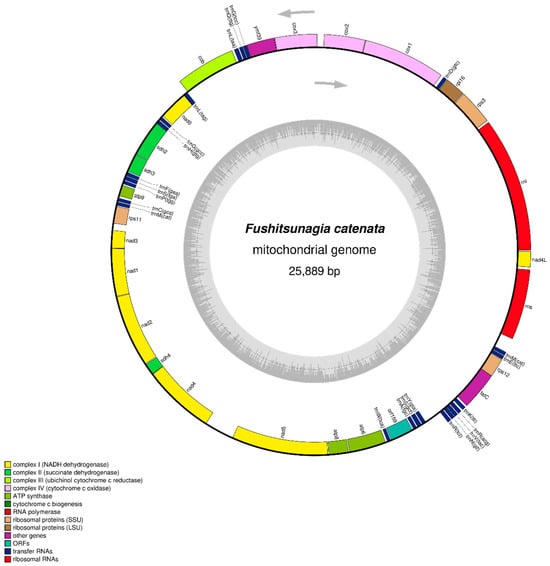
Figure 1
Open AccessArticle
Looking into the Eyes to See the Heart of Chronic Kidney Disease Patients
by
Maria Kislikova, Jorge Javier Gaitán-Valdizán, José Antonio Parra Blanco, María Teresa García Unzueta, María Rodríguez Vidriales, Clara Escagedo Cagigas, Vicente Celestino Piñera Haces, María de la Oliva Valentín Muñoz, Adalberto Benito Hernández, Juan Carlos Ruiz San Millan and Emilio Rodrigo Calabia
Life 2024, 14(4), 533; https://doi.org/10.3390/life14040533 - 22 Apr 2024
Abstract
In patients with chronic kidney disease (CKD), the main cause of morbidity and mortality is cardiovascular disease (CVD). Both coronary artery calcium scoring by computed tomography (CT) and optical coherence tomography (OCT) are used to identify patients at increased risk for ischemic heart
[...] Read more.
In patients with chronic kidney disease (CKD), the main cause of morbidity and mortality is cardiovascular disease (CVD). Both coronary artery calcium scoring by computed tomography (CT) and optical coherence tomography (OCT) are used to identify patients at increased risk for ischemic heart disease, thereby indicating a higher cardiovascular risk profile. Our study aimed to investigate the utility of these techniques in the CKD population. In patients with CKD, OCT was used to measure the choroidal thickness (CHT) and the thickness of the peripapillary retinal nerve fiber layer (pRNFL). A total of 127 patients were included, including 70 men (55%) with an estimated glomerular filtration rate (eGFR) of 39 ± 30 mL/min/1.73 m2. Lower pRNFL thickness was found to be related to high-sensitivity troponin I (r = −0.362, p < 0.001) and total coronary calcification (r = −0.194, p = 0.032). In a multivariate analysis, pRNFL measurements remained associated with age (β = −0.189; −0.739–−0.027; p = 0.035) and high-sensitivity troponin I (β = −0.301; −0.259–−0.071; p < 0.001). Severe coronary calcification (Agatston score ≥ 400 HU) was related to a worse eGFR (p = 0.008), a higher grade of CKD (p = 0.036), and a thinner pRNFL (p = 0.011). The ROC curve confirmed that the pRNFL measurement could determine the patients with an Agatston score of ≥400 HU (AUC 0.638; 95% CI 0.525–0.750; p = 0.015). Our study concludes that measurement of pRNFL thickness using OCT is related to the markers associated with ischemic heart disease, such as coronary calcification and high-sensitivity troponin I, in the CKD population.
Full article
(This article belongs to the Special Issue Chronic Renal Failure and Cardiovascular Disease—from Molecular Aspects to Clinical Practice)
►▼
Show Figures
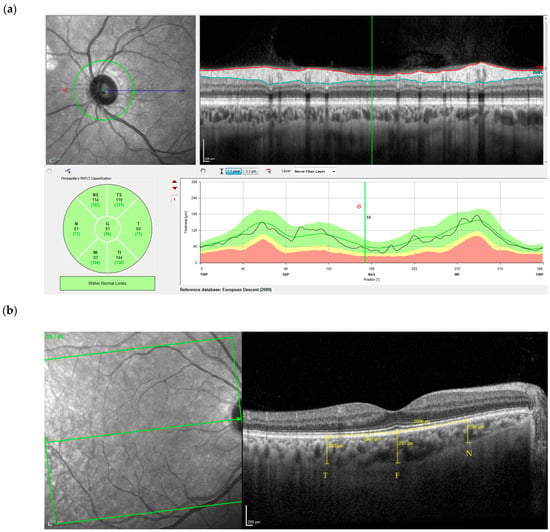
Figure 1
Open AccessArticle
Evaluating the Efficacy of Resect-and-Discard and Resect-and-Retrieve Strategies for Diminutive Colonic Polyps
by
Andrei Lucian Groza, Bogdan Miutescu, Cristian Tefas, Alexandru Popa, Iulia Ratiu, Roxana Sirli, Alina Popescu, Alexandru Catalin Motofelea and Marcel Tantau
Life 2024, 14(4), 532; https://doi.org/10.3390/life14040532 - 21 Apr 2024
Abstract
Background and Objectives: Diminutive polyps present a unique challenge in colorectal cancer (CRC) prevention strategies. This study aims to assess the characteristics and variables of diminutive polyps in a Romanian cohort, intending to develop a combined resect-and-retrieve or resect-and-discard strategy that reduces the
[...] Read more.
Background and Objectives: Diminutive polyps present a unique challenge in colorectal cancer (CRC) prevention strategies. This study aims to assess the characteristics and variables of diminutive polyps in a Romanian cohort, intending to develop a combined resect-and-retrieve or resect-and-discard strategy that reduces the need for an optical diagnosis. Materials and Methods: A prospective cohort study was conducted at two endoscopy centers in Romania from July to December 2021. Adult patients undergoing colonoscopies where polyps were identified and resected were included. Endoscopic procedures employed advanced diagnostic features, including blue-light imaging (BLI) and narrow-band imaging (NBI). Logistic regression analysis was utilized to determine factors impacting the probability of adenomatous polyps with high-grade dysplasia (HGD). Results: A total of 427 patients were included, with a mean age of 59.42 years (±11.19), predominantly male (60.2%). The most common indication for a colonoscopy was lower gastrointestinal symptoms (42.6%), followed by screening (28.8%). Adequate bowel preparation was achieved in 87.8% of cases. The logistic regression analysis revealed significant predictors of HGD in adenomatous polyps: age (OR = 1.05, 95% CI: 1.01–1.08, p = 0.01) and polyp size (>5 mm vs. ≤5 mm, OR = 4.4, 95% CI: 1.94–10.06, p < 0.001). Polyps classified as Paris IIa, Ip, and Isp were significantly more likely to harbor HGD compared to the reference group (Is), with odds ratios of 6.05, 3.68, and 2.7, respectively. Conclusions: The study elucidates significant associations between the presence of HGD in adenomatous polyps and factors such as age, polyp size, and Paris classification. These findings support the feasibility of a tailored approach in the resect-and-discard and resect-and-retrieve strategies for diminutive polyps, potentially optimizing CRC prevention and intervention practices. Further research is warranted to validate these strategies in broader clinical settings.
Full article
(This article belongs to the Special Issue Novel Diagnosis and Treatment of Gastrointestinal Disease)
►▼
Show Figures
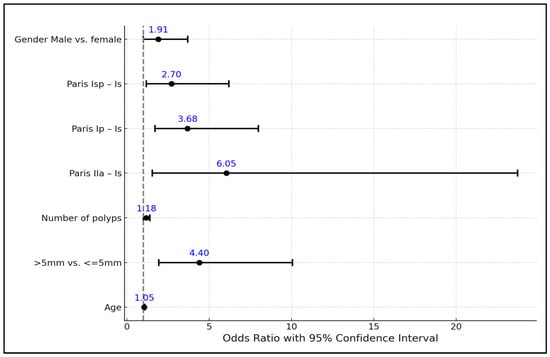
Figure 1
Open AccessArticle
Impact of Structural Compliance of a Six Degree of Freedom Joint Simulator on Virtual Ligament Force Calculation in Total Knee Endoprosthesis Testing
by
Eric Kleist, Paul Henke, Leo Ruehrmund, Maeruan Kebbach, Rainer Bader and Christoph Woernle
Life 2024, 14(4), 531; https://doi.org/10.3390/life14040531 - 21 Apr 2024
Abstract
The AMTI VIVO™ six degree of freedom joint simulator allows reproducible preclinical testing of joint endoprostheses under specific kinematic and loading conditions. When testing total knee endoprosthesis, the articulating femoral and tibial components are each mounted on an actuator with two and four
[...] Read more.
The AMTI VIVO™ six degree of freedom joint simulator allows reproducible preclinical testing of joint endoprostheses under specific kinematic and loading conditions. When testing total knee endoprosthesis, the articulating femoral and tibial components are each mounted on an actuator with two and four degrees of freedom, respectively. To approximate realistic physiological conditions with respect to soft tissues, the joint simulator features an integrated virtual ligament model that calculates the restoring forces of the ligament apparatus to be applied by the actuators. During joint motion, the locations of the ligament insertion points are calculated depending on both actuators’ coordinates. In the present study, we demonstrate that unintended elastic deformations of the actuators due to the specifically high contact forces in the artificial knee joint have a considerable impact on the calculated ligament forces. This study aims to investigate the effect of this structural compliance on experimental results. While the built-in algorithm for calculating the ligament forces cannot be altered by the user, a reduction of the ligament force deviations due to the elastic deformations could be achieved by preloading the articulating implant components in the reference configuration. As a proof of concept, a knee flexion motion with varying ligament conditions was simulated on the VIVO simulator and compared to data derived from a musculoskeletal multibody model of a total knee endoprosthesis.
Full article
(This article belongs to the Special Issue Advances in Knee Biomechanics)
►▼
Show Figures
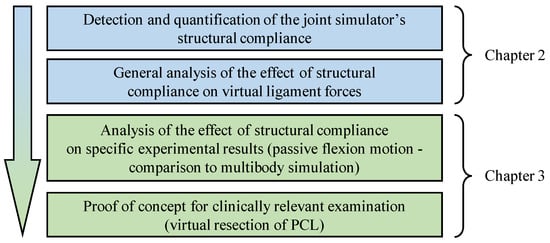
Figure 1
Open AccessArticle
The Association between Ovarian Cancer and the Incidence of Newly Developed Dry Eye Disease: A Nationwide Population-Based Study
by
Chia-Yi Lee, Shun-Fa Yang, Yu-Ling Chang, Jing-Yang Huang and Chao-Kai Chang
Life 2024, 14(4), 530; https://doi.org/10.3390/life14040530 - 21 Apr 2024
Abstract
We aim to investigate the potential correlation between the presence of ovarian cancer and the development of dry eye disease (DED) via the usage of the Longitudinal Health Insurance Database (LHID) of Taiwan. A retrospective cohort study was executed, and patients with ovarian
[...] Read more.
We aim to investigate the potential correlation between the presence of ovarian cancer and the development of dry eye disease (DED) via the usage of the Longitudinal Health Insurance Database (LHID) of Taiwan. A retrospective cohort study was executed, and patients with ovarian cancer were selected according to the diagnostic and procedure codes. One ovarian cancer patient was matched to four non-ovarian cancer participants which served as control group, and a total of 4992 and 19,968 patients constructed the ovarian cancer and control groups, respectively. The primary outcome in the current study is the development of DED according to the diagnostic and procedure codes. Cox proportional hazard regression was utilized to produce the adjusted hazard ratio (aHR) and related 95% confidence interval (CI) of DED between the two groups. There were 542 and 2502 DED events observed in the ovarian cancer group and the control group, respectively. The ovarian cancer group illustrated a significantly higher incidence of DED development than the control group after the adjustment of several confounders (aHR: 1.10, 95% CI: 1.01–1.21, p = 0.040). In the subgroup analysis stratified by age, ovarian cancer patients aged older than 60 years showed a higher incidence of DED compared to the non-ovarian cancer population (aHR: 1.19, 95% CI: 1.08–1.28, p = 0.011). In addition, ovarian cancer patients with a disease duration longer than five years also showed higher incidence of DED formation than the non-ovarian cancer population (aHR: 1.13, 95% CI: 1.04–1.22, p = 0.027). In conclusion, the presence of ovarian cancer is associated with higher incidence of subsequent DED, especially in those older than 60 years and with a disease interval of more than five years.
Full article
(This article belongs to the Special Issue Eye Diseases: Diagnosis and Treatment, 2nd Edition)
►▼
Show Figures
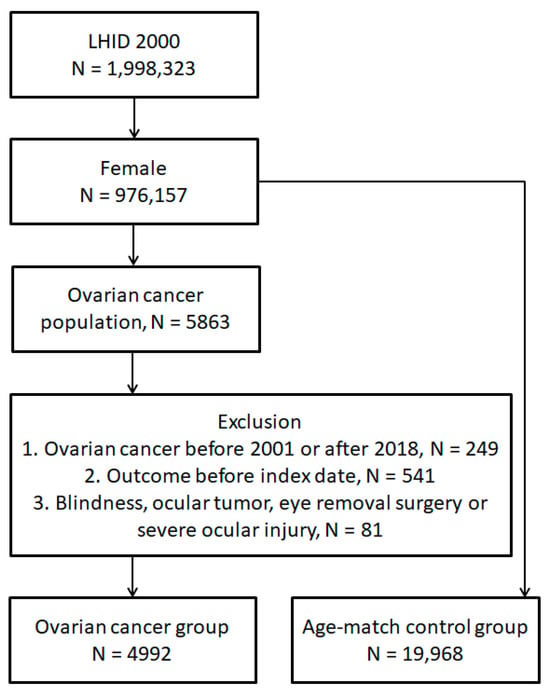
Figure 1
Open AccessArticle
Optimal Dietary Intake of Riboflavin Associated with Lower Risk of Cervical Cancer in Korea: Korean National Health and Nutrition Examination Survey 2010–2021
by
Seon-Mi Lee, Aeran Seol, Hyun-Woong Cho, Kyung-Jin Min, Sanghoon Lee, Jin-Hwa Hong, Jae-Yun Song, Jae-Kwan Lee and Nak-Woo Lee
Life 2024, 14(4), 529; https://doi.org/10.3390/life14040529 - 20 Apr 2024
Abstract
Background: This study aimed to evaluate the association between the dietary intake of vitamin B complex (thiamine, riboflavin, and niacin) and cervical cancer in Korea. Methods: The data from the Korean National Health and Nutrition Examination Survey (KNHANES) from 2010 to 2021 were
[...] Read more.
Background: This study aimed to evaluate the association between the dietary intake of vitamin B complex (thiamine, riboflavin, and niacin) and cervical cancer in Korea. Methods: The data from the Korean National Health and Nutrition Examination Survey (KNHANES) from 2010 to 2021 were analyzed, which included 28,306 participants who were categorized into non-cervical cancer and cervical cancer groups. The following dietary intake threshold levels of thiamine, riboflavin, and niacin were identified based on the recommended daily allowances (RDAs): thiamine, 1.1 mg/day; riboflavin, 1.2 mg/day; and niacin, 14 mg/day. Results: Among 28,306 participants, 27,976 were in the non-cervical cancer group and 330 were in the cervical cancer group. Riboflavin intakes of more than 1.2 mg/day but less than 2.4 mg/day were associated with a significantly reduced risk of cervical cancer, whereas intakes of above 2.4 mg/day were not associated with cervical cancer. Thiamine and niacin intakes were not significantly related to the risk of cervical cancer. Conclusions: The results of this study suggest that an intake of riboflavin of 1.2–2.4 mg/day may contribute to a lower risk of cervical cancer.
Full article
(This article belongs to the Special Issue Diagnosis and Treatment of Obstetrics and Gynecology Diseases)
►▼
Show Figures
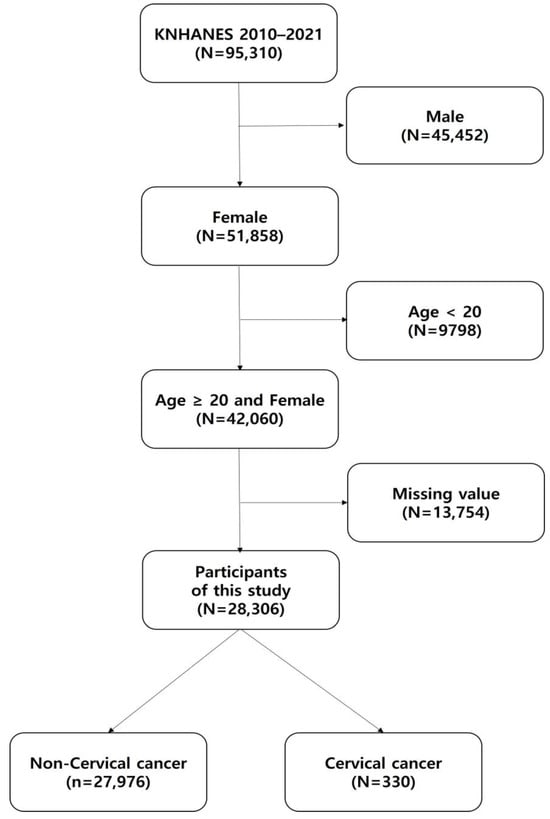
Figure 1
Open AccessReview
Botulinum Toxin in Chronic Lateral Epicondylitis, from Tendon to Muscle Approach—A Review
by
Daniela Poenaru, Miruna Ioana Sandulescu, Claudia-Gabriela Potcovaru and Delia Cinteza
Life 2024, 14(4), 528; https://doi.org/10.3390/life14040528 - 20 Apr 2024
Abstract
Background: Chronic lateral epicondylitis challenges the therapeutical approach; underlying mechanisms are incompletely understood; neuropathic pain and central and peripheral sensitization may explain the fact that botulinum toxin has been found to play a role in pain and function management. Methods: We searched the
[...] Read more.
Background: Chronic lateral epicondylitis challenges the therapeutical approach; underlying mechanisms are incompletely understood; neuropathic pain and central and peripheral sensitization may explain the fact that botulinum toxin has been found to play a role in pain and function management. Methods: We searched the literature for MeSH terms: lateral epicondylitis or synonyms and botulinum toxin. Results: We found 14 papers containing trials on botulinum toxin injection into the tendon or into the extensor muscles (specifically, extensor carpi radialis brevis and extensor communis digitorum). We followed the administration pathways, doses, timing, and side effects. Conclusions: With a chronic course, the focus of the therapy shifts from the afflicted tendon to the inserting muscles, as muscle contracture may create a vicious loop to perpetuate and aggravate the disease. Doses, timing, and side effects are discussed.
Full article
(This article belongs to the Special Issue Pathophysiology and Therapy of Neuropathic Pain)
►▼
Show Figures

Figure 1
Open AccessReview
Gut Microbiome and Its Role in Valvular Heart Disease: Not a “Gutted” Relationship
by
Gyanaranjan Nayak, Kyriakos Dimitriadis, Nikolaos Pyrpyris, Magdalini Manti, Nikolaos Kamperidis, Vasileios Kamperidis, Antonios Ziakas and Konstantinos Tsioufis
Life 2024, 14(4), 527; https://doi.org/10.3390/life14040527 - 19 Apr 2024
Abstract
The role of the gut microbiome (GM) and oral microbiome (OM) in cardiovascular disease (CVD) has been increasingly being understood in recent years. It is well known that GM is a risk factor for various CVD phenotypes, including hypertension, dyslipidemia, heart failure and
[...] Read more.
The role of the gut microbiome (GM) and oral microbiome (OM) in cardiovascular disease (CVD) has been increasingly being understood in recent years. It is well known that GM is a risk factor for various CVD phenotypes, including hypertension, dyslipidemia, heart failure and atrial fibrillation. However, its role in valvular heart disease (VHD) is less well understood. Research shows that, direct, microbe-mediated and indirect, metabolite-mediated damage as a result of gut dysbiosis and environmental factors results in a subclinical, chronic, systemic inflammatory state, which promotes inflammatory cell infiltration in heart valves and subsequently, via pro-inflammatory molecules, initiates a cascade of reaction, resulting in valve calcification, fibrosis and dysfunction. This relationship between GM and VHD adds a pathophysiological link to the pathogenesis of VHD, which can be aimed therapeutically, in order to prevent or regress any risk for valvular pathologies. Therapeutic interventions include dietary modifications and lifestyle interventions, in order to influence environmental factors that can promote gut dysbiosis. Furthermore, the combination of probiotics and prebiotics, as well as fecal m transplantation and targeted treatment with inducers or inhibitors of microbial enzymes have showed promising results in animal and/or clinical studies, with the potential to reduce the inflammatory state and restore the normal gut flora in patients. This review, thus, is going to discuss the pathophysiological links behind the relationship of GM, CVD and VHD, as well as explore the recent data regarding the effect of GM-altering treatment in CVD, cardiac function and systemic inflammation.
Full article
(This article belongs to the Special Issue Updates in Cardiovascular Medicine: Diagnosis, Treatment and Technical Aspects: 2nd Edition)
►▼
Show Figures
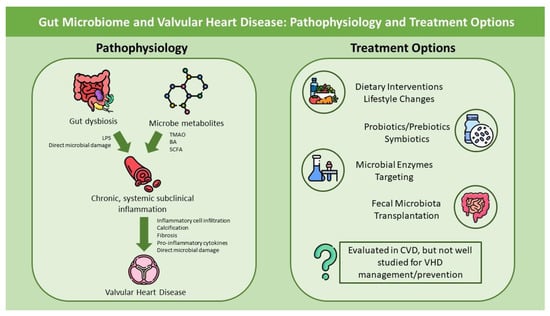
Figure 1

Journal Menu
► ▼ Journal Menu-
- Life Home
- Aims & Scope
- Editorial Board
- Reviewer Board
- Topical Advisory Panel
- Instructions for Authors
- Special Issues
- Topics
- Sections & Collections
- Article Processing Charge
- Indexing & Archiving
- Editor’s Choice Articles
- Most Cited & Viewed
- Journal Statistics
- Journal History
- Journal Awards
- Society Collaborations
- Conferences
- Editorial Office
Journal Browser
► ▼ Journal BrowserHighly Accessed Articles
Latest Books
E-Mail Alert
News
Topics
Topic in
Biomedicines, Cells, IJMS, Life, Oxygen
Oxidative Stress and Inflammation, 2nd Volume
Topic Editors: Mohamad Allaw, Ines Castangia, Maria Letizia Manca, Matteo Perra, Amparo NacherDeadline: 31 May 2024
Topic in
Geosciences, Life, Minerals, Quaternary
Palaeogeographic and Palaeoclimatic Changes Recorded by Microfossils
Topic Editors: Marta Bąk, Dangpeng Xi, Erik WolfgringDeadline: 30 June 2024
Topic in
Biomedicines, CIMB, Endocrines, IJMS, JMP, Life, Reprod. Med.
Pathogenesis of Pregnancy-Related Complications 2.0
Topic Editors: Ilona Hromadnikova, Katerina KotlabovaDeadline: 31 August 2024
Topic in
Brain Sciences, Clinics and Practice, COVID, Life, Vaccines, Viruses
Multifaceted Efforts from Basic Research to Clinical Practice in Controlling COVID-19 Disease
Topic Editors: Yih-Horng Shiao, Rashi OjhaDeadline: 30 September 2024

Conferences
Special Issues
Special Issue in
Life
Eimeria and the Future of Coccidiosis Control
Guest Editors: Virginia Marugan-Hernandez, Mariela TomazicDeadline: 25 April 2024
Special Issue in
Life
The Importance of Diagnosing and Predicting Rheumatic Diseases: Biomarkers, Indexes and Tools
Guest Editors: Nuria Montes, Santos CastanedaDeadline: 30 April 2024
Special Issue in
Life
Clinical Trends and Novel Research Insights in Testicular and Penile Disorders and Infertility
Guest Editor: Uroš BumbaširevićDeadline: 20 May 2024
Special Issue in
Life
Skin, Wound, Plastic Surgery and Hand Surgery
Guest Editors: Yuval Krieger, Yaron ShohamDeadline: 31 May 2024
Topical Collections
Topical Collection in
Life
Research Updates in Chronic Kidney Disease
Collection Editors: Emilio Nardi, Giuseppe Mule
Topical Collection in
Life
Male Infertility: Current Knowledge and Future Perspectives
Collection Editors: Renata Walczak-Jedrzejowska, Małgorzata Piasecka, Jolanta Słowikowska-Hilczer
Topical Collection in
Life
Feature Review Papers for Life
Collection Editors: Michael Russell, Dirk Schulze-Makuch, Kousuke Hanada, Stefanos Roumeliotis, Hiroki Nishikawa, Alfredo Conti
Topical Collection in
Life
The Role of Bioactive Natural Compounds in the Treatment of Diseases
Collection Editor: Stefania Lamponi






